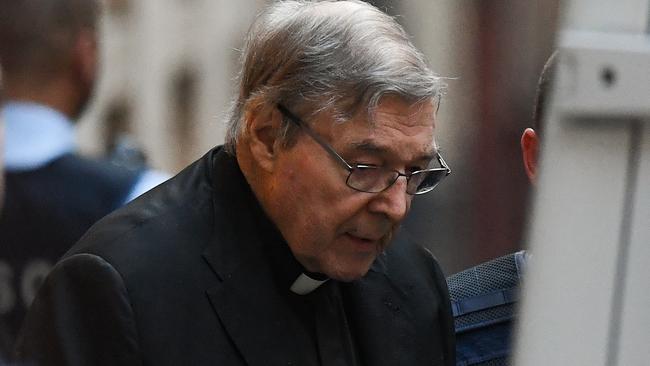
I understand the acute public interest in Pell’s trial, conviction and his subsequent unsuccessful appeal to the full bench of the Supreme Court of Victoria.
Tuesday’s announcement changes little. Its real impact is on the victim, known only by a pseudonym, and Cardinal Pell who has been returned to prison. There are others, close friends and family members of the victim and the perpetrator.
To some, the Pell verdict is the story. But, in reality, it is only a tiny fraction of it.
Many commentators continue to express the view that Pell is innocent. They are entitled to their opinions, but they carry little weight.
Certainly not the weight of a criminal conviction that has been subject to and upheld on appeal.
In the to-and-fro around the verdict and the subsequent appeal, what is missing is genuine focus.
Thirty years, 4444 victims
There is a fixation on one crime in a literal crime wave that is one of the darkest chapters of our social history.
The 4444 figure is an unforgettable one. That is the number the Catholic Church in Australia acknowledged as victims of child sexual abuse over a thirty-year period. One must imagine that figure is higher given that many victims have not reported and many never will.
We need to look wider, take a more panoramic view of what took place and why some dioceses or geographical areas of the Church had little or no offending while others like the Ballarat or the Maitland-Newcastle dioceses became veritable epidemics of child sex offending.
Or why some Catholic orders featured catastrophic levels of child abuse that went ignored for decades while others did not.
Even after three years of a Royal Commission, the answers are not immediately available.
In seminaries and novitiates, young men entered and had their psycho-sexual development frozen within the confines of an institution that shunned any discussion or consideration of human sexuality.
It is no surprise that these desires continued to exist at a teenage level. In many cases these desires were acted out on children in religious environments or at schools with little or no consequence.
The Seal of the Confessional
While that is no excuse, it is at some level an explanation. It does not, however, explain why some clerics preyed upon very young children.
There are other issues raised. The construct of celibacy among clerics is said to contribute to child sexual abuse. For me, it is something of a red herring. All priests are celibate but only a portion of them offend.
Then there is the vexed issue of the Seal of the Confessional that may prohibit clerics from reporting child sexual abuse from a confessor, be the offender a priest or lay person.
The Royal Commission found rare cases where the Seal of Confession may have prevented criminal action against a cleric or at least seen him removed from the company of children. It argued strongly that the seal be, in effect, broken.
The Andrews Government in Victoria is legislating to do so. The Victorian Government argues that nurses, police officers, doctors, social workers and teachers are legally bound to report reasonable suspicions of child sex abuse whereas clerics are not, but these are legal minds looking at matters of spirituality and faith with an eye only on black letter law interpretations.
In Unholy Trinity, the book I wrote with Denis Ryan, a former Victoria Police detective, we addressed the issue of the confessional. Ryan was a Catholic and visited the confessional at the Sacred Heart Church in Mildura weekly. On one occasion he mistakenly offered his confession to a particularly prolific paedophile priest, Monsignor John Day.
The question we asked in the book is that while Day made himself available to hear Ryan’s confession, who heard Day’s? Bearing in mind, of course, that Day had a considerable amount of sin to confess.
Of great interest to me is the role of policing and how it colluded historically with the Church to prevent the prosecution of offending clerics.
There are some uncomfortable facts. The first priest to be convicted of child sex offending in Australia was the Melbourne-based priest, Michael Glennon, in 1979. It would take a further 13 years for the second priest to be convicted, the now notorious Gerald Ridsdale.
The question remains if there was so much offending going on, why were there so few convictions? More broadly, if police would not act, it is entirely likely that these horrific crimes would not just continue but accelerate because offenders had learned they could prey on children without consequence.
No court grief for priests
Unholy Trinity was Denis Ryan’s story. Ryan was effectively ushered out of the Victoria Police Force in Mildura in 1972 for attempting to prosecute Monsignor John Day.
Ryan uncovered a group within the Victoria Police Force known in the colloquial as the Catholic Mafia. It was their job to ensure priests came to no grief in the courts.
The Royal Commission investigated the allegations raised by Denis Ryan in Unholy Trinity and found them proven. Sadly, and for reasons I do not understand to this day, the Commission made no further inquiries into this ugly form of police corruption.
There seems to have been an implicit assumption that what happened in Mildura in 1972, where senior police conspired with the then Bishop of Ballarat, Ronald Mulkearns, to remove Day from his Mildura parish and move him on to another, despite the existence of irrefutable evidence of his offending, ended there. No further questions, Your Honour.
Any sensible person would understand that police collusion with the Church to protect paedophile clerics would not have abruptly ended in 1972. The force was then, as it had been for decades, subject to sectarian tensions. A Victorian copper might then have been a Freemason or a Catholic, but he could not have been both.
But with Freemasonry now a mere vestige of Australian society, a part of an Australia that no longer exists and with it, the sectarian obsessions gone, have our police felt compelled to compensate in some way for the sins of the past by becoming more prosecutorial and keener to cut corners?
Focus on the entirety
These questions, all of them, are not simply matters of idle curiosity.
Of even greater concern is that the offending institutions having bowed their heads, shuffled their feet and stammered apologies in the Royal Commission, now have returned to playing hardball in the civil courts.
Many victims are taking their claims to the courts. The National Redress Scheme was created not so much for victims but to circumvent the mother of all bottlenecks to our legal system. That scheme continues to move at a glacial pace and victims are frustrated and angry with the process.
These are our people. They walk among us. They are, but for the grace of God, you and me. They were betrayed, had their innocence taken from them and now that we at least have some measure of their pain, we owe it to them not to focus on one matter, but the entirety of the offending and how and why our institutions failed them.
The Royal Commission left so many questions unanswered but there is little to be gained by a focus on one matter over another. We must understand the totality of what has happened because if we don’t, we run the risk of repeating the sins of the past. And that would be unforgivable.


